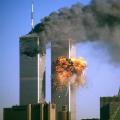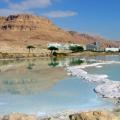Democratic Republic of the Congo.
The name of the country comes from the local name for the "river" - "kong".
Administrative divisions of the Congo... The state is divided into 9 regions and a metropolitan area.
Congo government... Republic.
Head of State of the Congo... President, term of office - 2 years.
Supreme Legislature of the Congo... Unicameral Legislative Council.
Higher executive agency Congo... Government.
Major cities of Congo... Lubumbashi, Kisangani.
Official language of the Congo... French.
Fauna of the Congo... Representatives of the Congo fauna are elephant, lion, leopard, chimpanzee, gorilla, giraffe, hippo, okapi, zebra, wolf, buffalo. Reptiles are numerous, among which the mamba (one of the most venomous snakes in the world), crocodile, and python stand out. From birds - flamingo, pelican, parrot, heron, sunflower, African clawed lapwing melt. A large number of insects also live, including the tsetse fly, an anopheles mosquito. There are many fish in the lakes (up to 1000 species).
Rivers and lakes of the Congo... The country has the densest river network in Africa. The main river is the Congo and its many tributaries. Many rivers abound with rapids and waterfalls.
Congo landmarks... In Kinshasa - the National Museum, in Lubumbashi - the Museum of African Art, in Eala - a huge Botanical Garden, in Likasi - the geological museum. Natural attractions include nature reserves, national parks, and colorful waterfalls, such as the Livingston Waterfalls Cascade of 70 in the lower Congo, close to the ocean.
Useful information for tourists
The peoples of the Congo have a rich cultural tradition - music, dance and art. Crafts such as wood carving, bones, and basket weaving have survived everywhere. Of particular interest are wooden sculptures and masks with distinctive features each ethnic group.
It shares borders with Gabon, Cameroon, Central African Republic, Democratic Republic of Congo and Angola. Has access to the Atlantic Ocean.
State symbols
Flag- is a rectangular panel with an aspect ratio of 2: 3 with diagonally located stripes of green, yellow and red (Pan-African colors). The flag was approved on August 18, 1958, canceled on December 30, 1960, and reapproved on June 10, 1991.

Coat of arms- is a shield, in a golden field of which there is a green wavy belt, covered by a scarlet rebellious lion with green arms and a tongue holding a black torch with a scarlet flame in its right paw; the shield is topped with a stylized gold crown with a black inscription on the hoop in French: "Republic of the Congo". The shield is supported by two black African elephants emerging, standing on a scarlet base, from which hangs a gold ribbon with the national motto in French: "Unity, Labor, Progress."
State structure
Form of government- presidential republic.
Head of state- the president. Elected by the population for a 7-year term with the possibility of re-election for a second term.
Current President 1979-1992 and since 1997 Denis Sassou-Nguesso
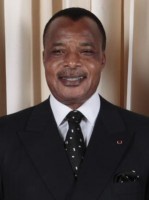
Capital and largest city- Brazzaville.
official languages- French, kituba, lingala.
Territory- 342,000 km².
Administrative division- 12 departments, including the capital city of Brazzaville and the city of Pointe Noire.
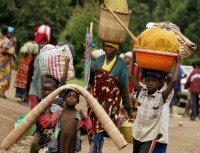
Population- 4,233,063 people It is one of the most sparsely populated countries in Africa. The least population lives in the northern regions of the country, which are completely covered with swamps and impassable wet forests... Most of the population belongs to the Bantu peoples; pygmy settlements have survived in the dense forests. Cities are home to about half of the Congo's population.
Religion- Christians (mainly Catholics) 50%, aboriginal cults 48%, Muslims 2%.
Currency- CFA franc.
Economy- the basis of the economy is oil production and export. Industry: oil production, cement production, timber, brewing, sugar, palm oil, soap, cigarette production. Agriculture: cassava (tapioca), cassava, sugarcane, rice, corn, peanuts, vegetables, coffee, cocoa. Export: oil, timber, sugar, cocoa, coffee, diamonds. Import: industrial products, building materials, food.
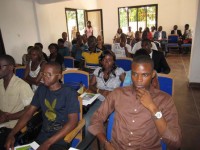
Education- primary education - 6 years of study. Lower secondary education takes 4 years (grades 7-10). Upon completion of this level of education, students receive the Brevet d "Etudes du Premier Cycle (BEPC).
3-year senior secondary education (grades 11-13). Upon completion of this stage, students take the Baccalaureat exam, which can be obtained in different study profiles, depending on the specialization.
Students who fail the specified exams receive a Certificat de Fin d "Etudes Secondaires", an academic record of attendance and grades received in the last academic year.
Technical secondary education - upon completion of lower secondary education 2-3 years.
To enter a university, it is enough to have a Baccalaureat.
Sport- the most popular are football and basketball. The country took part in the 10 Summer Olympics, debuting at the Tokyo Summer Olympics (1964) Since then, it has participated in all Summer Games except the Mexico City and Montreal Games. The Republic of the Congo did not participate in the Winter Olympics. The athletes of this country have never won Olympic medals.
Military establishment- regular armed forces, paramilitaries, gendarmerie, air force, navy. Recruiting on a voluntary basis.
Nature
Most of the country is occupied by the accumulative plains of the Congo Basin. This is the land of vast swamps and rivers - tributaries of the Congo and Ubangi.

Congo river
The largest valley of the Niari River is famous for its fertility. Further to the southwest rise the Mayombe Mountains, composed of granite, quartzite and shale, with an average elevation of 700–800 m. These mountains drop abruptly to a coastal lowland 50–60 km wide, which is crossed by river valleys. The largest of these is the Kuimu River, a continuation of the Niari.
Climate equatorial. Maximum precipitation is from March to April. It is at this time that the maximum precipitation falls.
In the northern and mountainous areas Congo common wet rainforests, mostly swampy and periodically flooded. Tall grass savannas are widespread in the south.
Coffee plantations are the pride of the country.
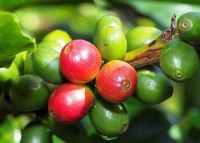
Odzala National Park and Biosphere Reserve
Odzala Park is located in the southern part of the forest, stretching from Gabon to the Democratic Republic of the Congo. In the southern part, there is mainly a mixture of coniferous forest and savanna, for the north, continuous forest is characteristic. A large area of the park is covered with swampy forests.
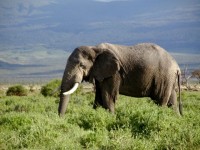
Bush elephant
The park is home to the bush elephant, African pygmy buffalo, bongo, western gorilla, common chimpanzee, lion, leopard, spotted hyena, and a large forest pig.

Big forest pig
440 bird species, 330 of which nest and breed. Rare species include the forest hoopoe, the red-breasted motley-bellied hornbeak, the brown-cheeked warbler, the black-throated apalis, the dark-backed cysticola, and the yellow-capped weaver. The park is also inhabited by the African forest robin, steppe kestrel, steppe tirkushka, great snipe, etc.
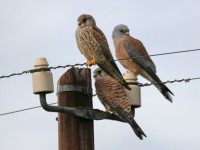
Steppe kestrel
The national park was established in 1935. Vast forests to the north, east and west of the park were added to it in 2001.
Tourism
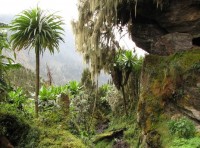
Tourism in the country is practically undeveloped. This is partly due to the very uncomfortable climate for Europeans: high humidity in the background high temperatures... But the magnificent nature, the richest fauna, unique temples and museums are gradually attracting more and more travelers. V national parks antelopes, giraffes, cheetahs, crocodiles, many species of birds and snakes are protected. These are the last habitats of the forest leopard and black gorillas.
Culture
Modern literature (mostly in French) began to take shape in the 1950s.
Famous J.F. Chikaya U Tamsi (1931-1988), author of the books "Bad Blood" (1955), "Belly" (1964). Many anti-colonial works have been published.
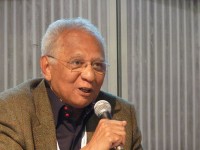
Angi Lopez
One of the most famous representatives of modern African literature isAngi Lopez(p. 1937). He is a Congolese writer and politician. From 1949 to 1965 lived in France. 1973 to 1975 served as Prime Minister of the Government of the Republic of the Congo. His famous novels: "Without tam-tam" (1976), "Laughter through tears" (1984).

The traditional types of folk dwellings in different regions of the Republic of the Congo differ: in the savannah regions they are round, in the forest zone they are rectangular with gable roofs, in the Sanga River valley the roofs are woven from twigs and branches and resemble a turtle shield in shape.
Buildings of the European type began to be built in Brazzaville, Pointe-Noire, and some other cities in the second half of the 19th century.
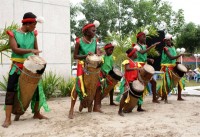
Music usually accompanies cult rites: ancestor cult, healing and calendar.
Wood carving is popular.

She is decorated with furniture, wooden household items, calabash (vessels made of dried pumpkin), pottery, as well as masks and wooden sculptures and figurines.
Congo's contemporary visual arts are a mixture of local flavors and the French school of painting. Here is both expressiveness and dynamism, clarity and richness of African colors. Gouache and watercolor are popular.
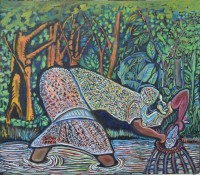
Peculiarity national cuisine: an abundance of spices and herbs that are added to almost any dish: soups, meat or fish. A traditional Congo lunch begins with a rich thick soup spiced with pepper, saffron, ginger, nutmeg or cloves. Capers, lemons and plenty of greens are also added.
Lamb with figs, camel and pigeon meat are popular in Congo. Fish stuffed or baked with cheese is often served on the table.
UNESCO World Heritage Sites in the Republic of the Congo
Sangha Forest
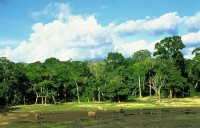
Rainforest and national park, located on both banks of the African region of Sanga on the territory of three states at once: the Republic of the Congo, the Central African Republic and Cameroon.
The forest includes three national parks:
Lobeke in Cameroon;
Dzanga-Sanga in the Central African Republic;
Nubale Ndoki in the Republic of the Congo.
The Sangha forest landscape consists of deciduous evergreen rain forests, forest bogs and intermittently inundated wetlands, lakes, and several types of open savannah areas. In addition to the natural beauty itself, the forest is valuable for the opportunity to conduct scientific research and hiking trips there.
The area is well preserved compared to many other areas in the Congo Basin due to its low human presence. And now economic activity in the forest is minimal, and the population density around it is low.
Various species of animals live in the forest, some of them are endemic, others are rare or endangered species. The Sangha River is home to large populations of the Nile crocodile and the predatory Big Tiger Fish, which can grow up to 1.33 m in length.

Big tiger fish
Populations of the African forest elephant, large populations of gorillas and chimpanzees, most of which have never met humans, several species of antelope (sitatunga and bongo), buffalo and several species of wild boar.
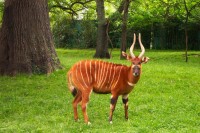
Bongo antelope
Other sights of the Republic of the Congo
Brazzaville
Nabemba tower
The capital and the most populous city Republic of the Congo. Located on the right bank of the Congo River. The population is about 1.5 million people. Is a third of the population of the Republic of the Congo.
Brazzaville is the cultural center of the Republic of the Congo. It has the largest number of primary, secondary and vocational schools in the country. The National University has been functioning since 1972, National Museum and a national theater.
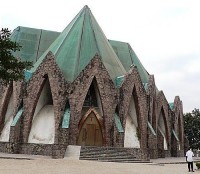
The main attractions in Brazzaville include Roman Catholic Cathedral of St. Anne, built in 1949, the mausoleum of the founder of the city, Pierre Savornyan de Brazza, the museum of crafts, the presidential palace, the building of the city hall, the National Museum of the Congo. Notable buildings include the Nabemba Tower and the Air France office.
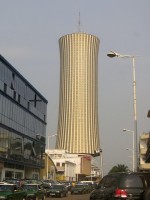
Nabemba Tower- high-rise building (30 floors). Designed by French architect Jean Marie Legrand and built 1982-1986. Named after the mountain of the same name, the highest in the territory of the Republic of Congo. The tower houses the headquarters of the Elf-Congo oil company, various institutions, offices international organizations, including UNESCO.
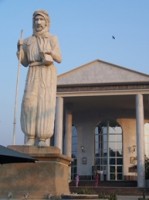
Monument to Pierre Savornyan de Brazza
History
In ancient times, the territory of the Congo was inhabited by pygmies who were engaged in hunting and gathering. Around the VI-IX centuries. came the Bantu tribes, now constituting 98% of the population.
The Bantu tribes were engaged in hoe, slash-and-burn agriculture and cultivated sorghum, legumes, yams. They lived mainly in a primitive communal system, but some tribes already had slavery.
In 1482, Portuguese sailors appeared at the mouth of the Congo River under the command of Diogo Cana. V early XVI v. the Portuguese began to export slaves bought from coastal tribes from the Congo to Brazil.
Colonization
V late XIX v. the French arrived in the Congo. In 1880, French naval officer Pierre de Brazza established the post of Ncuna (Brazzaville, capital of the Republic of Congo). By 1883, the French Congo was formed.
Since 1906, after the division of the French Congo, the territory of the modern Republic of the Congo became part of the Middle Congo colony, then became part of the French Equatorial Africa... In 1947, Congo was granted the status of an overseas territory of France, and since 1958 - the status of an autonomous republic within the French community.
Independence of the Congo
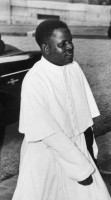
Fulber Yulu
On August 15, 1960, the independence of the Republic of the Congo was proclaimed. The first president was Abbot Fulbert Yulu, who was ousted on 15 August 1963 in a powerful union-inspired protest against administrative corruption in the face of a deteriorating economic situation.
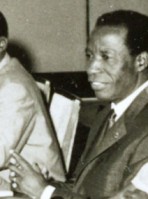
Alphonse Massamba-Deba
On August 16, 1963, a provisional government came to power headed by Alphonse Massamba-Deba, who became president in December 1963. A course was announced for building a socialist society, a five-year plan was introduced, and the property of foreign companies was requisitioned.
In August 1968, Massamba-Deba was overthrown in a coup led by Captain Marian Ngouabi. Ngouabi announced the continuation of the course of building socialism on the Soviet model. In 1969, he created the Congolese Labor Party, the ruling and only party in the country. The country's parliament was abolished, its functions were taken over by the Central Committee of the CPT.
In March 1977, Ngouabi was assassinated by supporters of the former ruler of the country, Massamba-Deba. Power was taken by the military committee of the CPT, headed by Joaquim Yombi-Opango. Former President Massamba-Deba was executed as the leader of the conspirators.
In March 1979, Colonel Denis Sassou-Nguesso became the president of the Congo - the chairman of the party, head of government and concurrently Minister of Defense, Minister of State Security and Minister of the Interior. He, like his predecessors, continued the course of building Soviet-style socialism.
1990-1991 the ruling CPT party lost the first multiparty elections and went over to the opposition.
In the period from 1992 to 1997. the country was ruled by weak coalition governments, the result was political instability.
In 1997, massive clashes began between supporters of the main candidates, which escalated into a civil war. Neighboring countries took a significant part in the civil strife. The Angolan army played a decisive role in the final victory of Sassou-Nguesso.
In 2001-2002. Sassou Nguesso undertook the process of reestablishing political liberalization, and in 2002 was elected president of the republic for a 7-year term.
CONGO, Republic of the Congo, a state in Central Africa. Former colony of France, gained independence in 1960. In the southwest it is washed by the waters Atlantic Ocean, borders in the south with Angola (Cabinda exclave), in the east - with the Democratic Republic of the Congo (DRC), in the north - with Cameroon and the Central African Republic, in the west - with Gabon.
During the colonial period, called Middle Congo, the country was part of French Equatorial Africa. After receiving autonomy status in 1958 within the French Community former colony chose the name Republic of the Congo for itself. It retained this name until 1970. In 1970-1991 - People's Republic of the Congo. The name Congo (Brazzaville) is often used as opposed to Congo (Kinshasa), the Democratic Republic of the Congo.
The area of the country is 342 thousand square meters. km, population 4.5 million (2013). The main cities are Brazzaville (1611 thousand inhabitants, 2010), the capital of the country and a large port on the Congo River, Pointe Noire (576 thousand), a port on the Atlantic coast.
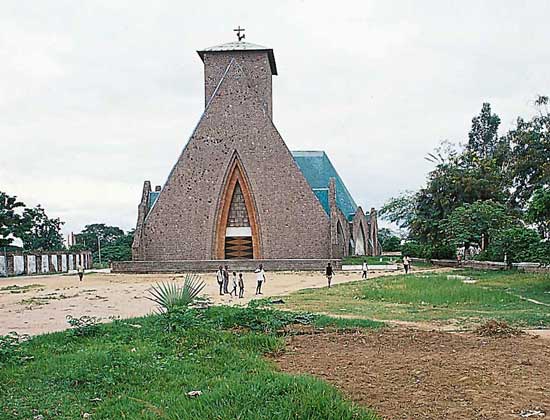
NATURE
The coastline is leveled, its length is approx. 170 km. Most of the country is occupied by the accumulative plains of the Congo Basin. This is the land of vast swamps and rivers - tributaries of the Congo and Ubangi. On the periphery of the depression in the northern, western and partly central regions developed plains and stepped plateaus. A typical example is the Bateke plateau with a height of 650-850 m, where there are no rivers and many large suffusion sinkholes. To the southwest of it is the Niari-Nyanga depression, where a hilly landscape with a dense river network is developed. The largest valley of the Niari River is famous for its fertility. Further to the southwest rise the folded-block Mayombe mountains, composed of granite, quartzite and shale, with an average height of 700-800 m. These mountains drop abruptly to a coastal lowland 50-60 km wide, which is crossed by river valleys. The largest of them is the Kuimu River - an extension of the Niari River.
The country's climate is equatorial. In the south, the dry season lasts from June to the end of September, and the wet season from March to April. It is at this time that the maximum precipitation falls. The average annual quantity precipitation 1200 mm. The dry season is characterized by the lowest average monthly temperatures (21 ° C). average temperature the hottest month, March, reaches 30 ° C. The cold Benguela current, passing near the coast, has a softening effect on the climate here. In the central part of the country, the hottest month is January, and the wettest is July. Average annual quantity precipitation is 1600-2000 mm. The average temperature in Jambar, the coldest month, July, is 22 ° C, and the warmest, April, 24 ° C. In the north of the country, there are two seasons of heavy tropical rains - in October and April. Almost no month is truly dry or cool. The average annual rainfall reaches 2500 mm. The average temperature of the hottest month, April, at Veso station is 27 ° С, and the coldest month, August, 25 ° С.
Most of the rivers belong to the Congo basin. The exception is the Niari-Kuilu river. The length of navigable routes in the country is 3200 km, including some sections of the Ubangi and Congo rivers. In some places, rapids and waterfalls impede navigation.
In the northern and mountainous regions of the Congo, tropical rainforests are widespread, largely swampy and periodically inundated. The total forested area is approx. 50% of the country's territory. Tall grass savannas are widespread in the south. The tree layer there can be dense or sparse, and sometimes even absent, but this has little effect on the nature of the herbage.
POPULATION
More than half of the population lives in cities. The urban population is concentrated mainly in Brazzaville, Pointe Noire and Loubomo. The unemployment rate is high in these cities. Congo has a high proportion of employees, and trade unions are the most organized and influential in Equatorial Africa. The adult literacy rate reaches 63%.
Almost 30% of Congo residents are Bakongo people, who maintain close ties with their fellow tribesmen living in the territory. neighboring countries... The main occupations are agriculture and trade. In the 16th century. The Bakongos were subjects of the Christian Kingdom of the Congo, which established diplomatic relations with Portugal. The kingdom fell due to internal strife and intrigues of Europeans, including slave traders. Mboshi, who make up 12% of the country's population, live in the northern regions on the border of savannahs and forests. Previously, they were mainly engaged in fishing, now many of them have moved to cities, where, thanks to the patronage of their fellow countrymen, who occupy leading positions, they join the ranks of employees. To the south is the area of settlement of bateke (13% of the country's population), which to the greatest extent preserved traditional way life. The main occupation is agriculture, the secondary occupation is hunting and fishing. The extreme north of the Congo is an area of dispersed settlement of the Sanga and many other peoples. Some of them maintain contacts with pygmies who live in the forests and supply game in exchange for agricultural products. Wooden sculptures of the few peoples of the Congo, in particular the bateque and babembe, have had a great influence on world art. The famous wooden sculptures of mother and child, created by the craftsmen of the Bakongo people, played the same role. Congolese artists associated with the Poto-Poto school of painting in Brazzaville have created original works that are in high demand around the world.
The Bantu languages are widely spoken in the Congo. The Lingala language is used for interethnic communication in the middle reaches of the Congo River. Official language countries - French.
Public education.
By the mid-1980s, most school-age children were in school. In 1990, there were 503,000 students in primary schools, 237,000 in secondary schools, and 32,000 in vocational schools. In 1991 in National University Brazzaville, which opened in 1972, had 12,000 students. As a consequence economic crisis and civil wars in the 1990s, the number of schoolchildren and students declined sharply.
The literacy rate in 2005 was 86% - one of the highest in Africa.
Republic of the Congo, a state in Central Africa. The former colony of France, which gained independence in 1960. In the south-west it is washed by the Atlantic Ocean, borders in the south with Angola (exclave of Cabinda), in the east - with the Democratic Republic of the Congo (DRC), in the north - with Cameroon and the Central African Republic,
During the colonial period, called Middle Congo, the country was part of French Equatorial Africa. After receiving autonomy status within the French Community in 1958, the former colony chose the name of the Republic of the Congo for itself. It retained this name until 1970. In 1970-1991 - People's Republic of the Congo. The name Congo (Brazzaville) is often used as opposed to Congo (Kinshasa), the Democratic Republic of the Congo.
The area of the country is 342 thousand square meters. km, population 3.90 million people (2008 estimate). The main cities are Brazzaville (1170 thousand inhabitants, 2003), the capital of the country and a large port on the Congo River, Pointe Noire (576 thousand), a port on the Atlantic coast.
NATURE
The coastline is leveled, its length is approx. 170 km. Most of the country is occupied by the accumulative plains of the Congo Basin. This is the land of vast swamps and rivers - tributaries of the Congo and Ubangi. On the periphery of the depression, in the northern, western, and partly central regions, there are stratal plains and stepped plateaus. A typical example is the Bateke plateau with a height of 650-850 m, where there are no rivers and many large suffusion sinkholes. To the southwest of it is the Niari-Nyanga depression, where a hilly landscape with a dense river network is developed. The largest valley of the Niari River is famous for its fertility. Further to the southwest rise the folded-block Mayombe mountains, composed of granite, quartzite and shale, with an average height of 700-800 m. These mountains drop abruptly to a coastal lowland 50-60 km wide, which is crossed by river valleys. The largest of them is the Kuimu River - an extension of the Niari River.
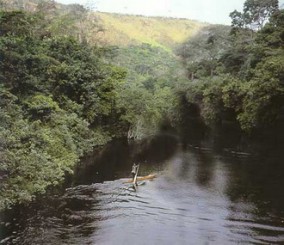 The country's climate is equatorial. In the south, the dry season lasts from June to the end of September, and the wet season from March to April. It is at this time that the maximum precipitation falls. Average annual precipitation is 1200 mm. The dry season is characterized by the lowest average monthly temperatures (21 ° C). The average temperature of the hottest month, March, reaches 30 ° C. The cold Benguela Current, passing near the coast, has a softening effect on the climate here. In the central part of the country, the hottest month is January, and the wettest is July. Average annual precipitation is 1600-2000 mm. The average temperature in Jambar, the coldest month, July, is 22 ° C, and the warmest, April, 24 ° C. In the north of the country, there are two seasons of heavy tropical rains - in October and April. Almost no month is truly dry or cool. The average annual rainfall reaches 2500 mm. The average temperature of the hottest month, April, at Veso station is 27 ° С, and the coldest month, August, 25 ° С.
The country's climate is equatorial. In the south, the dry season lasts from June to the end of September, and the wet season from March to April. It is at this time that the maximum precipitation falls. Average annual precipitation is 1200 mm. The dry season is characterized by the lowest average monthly temperatures (21 ° C). The average temperature of the hottest month, March, reaches 30 ° C. The cold Benguela Current, passing near the coast, has a softening effect on the climate here. In the central part of the country, the hottest month is January, and the wettest is July. Average annual precipitation is 1600-2000 mm. The average temperature in Jambar, the coldest month, July, is 22 ° C, and the warmest, April, 24 ° C. In the north of the country, there are two seasons of heavy tropical rains - in October and April. Almost no month is truly dry or cool. The average annual rainfall reaches 2500 mm. The average temperature of the hottest month, April, at Veso station is 27 ° С, and the coldest month, August, 25 ° С.
Most of the rivers belong to the Congo basin. The exception is the Niari-Kuilu river. The length of navigable routes in the country is 3200 km, including some sections of the Ubangi and Congo rivers. In some places, rapids and waterfalls impede navigation.
In the northern and mountainous regions of the Congo, tropical rainforests are widespread, largely swampy and periodically inundated. The total forested area is approx. 50% of the country's territory. Tall grass savannas are widespread in the south. The tree layer there can be dense or sparse, and sometimes even absent, but this has little effect on the nature of the herbage.
POPULATION
More than half of the population lives in cities. The urban population is concentrated mainly in Brazzaville, Pointe Noire and Loubomo. The unemployment rate is high in these cities. Congo has a high proportion of employees, and trade unions are the most organized and influential in Equatorial Africa. The adult literacy rate reaches 63%.
Almost 30% of Congo residents are Bakongo people, who maintain close ties with their fellow tribesmen living in neighboring countries. The main occupations are agriculture and trade. In the 16th century. The Bakongos were subjects of the Christian Kingdom of the Congo, which established diplomatic relations with Portugal. The kingdom fell due to internal strife and intrigues of Europeans, including slave traders. Mboshi, who make up 12% of the country's population, live in the northern regions on the border of the savannah and  forests. Previously, they were mainly engaged in fishing, now many of them have moved to cities, where, thanks to the patronage of their fellow countrymen, who occupy leading positions, they join the ranks of employees. To the south is the area of settlement of bateke (13% of the country's population), which to the greatest extent have preserved their traditional way of life. The main occupation is agriculture, the secondary occupation is hunting and fishing. The extreme north of the Congo is an area of dispersed settlement of the Sanga and many other peoples. Some of them maintain contacts with pygmies who live in the forests and supply game in exchange for agricultural products. Wooden sculptures of the few peoples of the Congo, in particular the bateque and babembe, have had a great influence on world art. The famous wooden sculptures of mother and child, created by the craftsmen of the Bakongo people, played the same role. Congolese artists associated with the Poto-Poto school of painting in Brazzaville have created original works that are in high demand around the world.
forests. Previously, they were mainly engaged in fishing, now many of them have moved to cities, where, thanks to the patronage of their fellow countrymen, who occupy leading positions, they join the ranks of employees. To the south is the area of settlement of bateke (13% of the country's population), which to the greatest extent have preserved their traditional way of life. The main occupation is agriculture, the secondary occupation is hunting and fishing. The extreme north of the Congo is an area of dispersed settlement of the Sanga and many other peoples. Some of them maintain contacts with pygmies who live in the forests and supply game in exchange for agricultural products. Wooden sculptures of the few peoples of the Congo, in particular the bateque and babembe, have had a great influence on world art. The famous wooden sculptures of mother and child, created by the craftsmen of the Bakongo people, played the same role. Congolese artists associated with the Poto-Poto school of painting in Brazzaville have created original works that are in high demand around the world.
The Bantu languages are widely spoken in the Congo. The Lingala language is used for interethnic communication in the middle reaches of the Congo River. The official language of the country is French.
Public education.
By the mid-1980s, most school-age children were in school. In 1990, there were 503,000 students in primary schools, 237,000 in secondary schools, and 32,000 in vocational schools. In 1991, the National University in Brazzaville, which opened in 1972, had 12,000 students. Due to the economic crisis and civil wars in the 1990s, the number of schoolchildren and students fell sharply.
The literacy rate in 2005 was 86% - one of the highest in Africa.
POLITICAL SYSTEM
According to the 2002 constitution, the president is elected in a general election for a term of 7 years. The President forms the Cabinet of Ministers. The legislature is the National Assembly of 137 deputies and the Senate of 66 senators.
Foreign policy.
Even after gaining independence, the Congo maintained close ties with France, although relations between them deteriorated during the period of the country's orientation towards the socialist path of development. From the mid-1960s, the Congo cooperated first with China, and then with the USSR, and until the end of the 1980s received substantial assistance from these states. Taking advantage of the contradictions between these socialist countries, as well as between them and France, the Congo sought to achieve an increase in the volume of foreign aid.
France had a significant impact on domestic policy Congo throughout the post-colonial period. During the 1997 civil war, certain forces in the French government and in the Elf-Akitain oil company advocated the return of Sassou Nguesso to power. The United States actively supported the Lissouba regime in words, but their real help was negligible. France feared that the Lissouba government might undermine Elf-Akiten's influence in the Congo. With the return to power of Sassou-Nguesso, Franco-Congolese relations received a new impetus. The main aid came from France to the Congo, including most of the imported goods. Congolese exports, mainly oil, went to countries Western Europe and the USA.
Congo is a member of the UN and the Organization of African Unity, as well as the Customs and Economic Union Central Africa(UDEAC). In 1958-1975 the country was an associated member of the EEC.
ECONOMY
Approximately 60% of the working-age population is employed in agriculture oriented towards the domestic market. Most of the wage earners work in the civil service, in the timber and oil industries, on export crop plantations, and in the service sector. After the abolition of French Equatorial Africa in 1957, the Congo lost a significant part of the income that it received as the administrative center of this union of the colonial possessions of France, where it was located military base metropolis. In 1996, the country's GDP was approx. $ 2.12 billion, or approximately $ 770 per capita. The aggregate share of the products of agriculture, cattle breeding, forestry and fishing in GDP is approx. 15%. Congo plays an important role as a trading and transit state in Central Africa. A significant source of income is the provision of transport, trade and other services. 35% of GDP is accounted for by the oil industry. In 1973-1985, when world oil prices were quite high, Congo's GDP grew at a rapid pace, but after falling prices in 1986, it fell sharply. Despite the increase in oil production in the 1990s, there has never been a real economic recovery.
![]() Most of the population is engaged in cultivation for their own consumption and sale on the domestic market of cassava and bananas (the main food crops), as well as yams and a small amount of some other crops. Export crops (sugar cane, oil palm, coffee and cocoa trees, tobacco and peanuts) are cultivated mainly on plantations owned by Europeans. Livestock production is limited due to the widespread distribution of the tsetse fly, a carrier of a form of sleeping sickness that is fatal to cattle. Most of Congo's meat needs are met by imports from Chad. Only 2% of the land is cultivated, and as the urban population grows, food imports increase.
Most of the population is engaged in cultivation for their own consumption and sale on the domestic market of cassava and bananas (the main food crops), as well as yams and a small amount of some other crops. Export crops (sugar cane, oil palm, coffee and cocoa trees, tobacco and peanuts) are cultivated mainly on plantations owned by Europeans. Livestock production is limited due to the widespread distribution of the tsetse fly, a carrier of a form of sleeping sickness that is fatal to cattle. Most of Congo's meat needs are met by imports from Chad. Only 2% of the land is cultivated, and as the urban population grows, food imports increase.
The largest source of state revenue is oil, the deposits of which were explored in 1957. At present, the shelf deposits of Emerod, Loango, Likuala are being developed. Since 1973, Congo has been exporting a significant part of the oil produced. From 1985 to 1997, the country's annual oil production increased from 6.3 million tons to 13 million. The timber of valuable tropical species, mainly okoume, limba and acaju, is also a profitable export item. From 1969 to 1977, the development of potash reserves in the Pointe Noire area was carried out, but due to flooding, the mine was out of order, and production was stopped. Reserves of high quality iron ore have been explored.
At the first stage, the industrialization of the Congo was facilitated by the presence in the country of first-class ports - the sea at Pointe Noire and the river at Brazzaville - and the fact that for a long time the country was administrative center former French Equatorial Africa. In the early 1980s, the share of manufacturing in GDP increased markedly, while the imperfection of the state planning system began to appear. Currently, the country has established the production of beer and soft drinks, canned vegetables and fruits, sugar, flour and fish products. There are enterprises for the production of tobacco and cigarettes, wood products, including timber and plywood, cement, soap and footwear. In the early 1970s, a shipyard built with Chinese assistance was commissioned. In 1976, an oil refinery at Pointe-Noire with a capacity of 1 million tons of crude oil per year was commissioned. In the period from the late 1960s to the mid-1980s, the state nationalized the existing ones and built new ones. industrial enterprises... Since then, successive governments have sought to privatize most state and parastatal enterprises. Among the recently privatized is Hydro-Congo, a former state-owned refined product distribution company. Electricity for businesses and residential buildings comes from TPPs in Pointe Noire and Brazzaville and hydroelectric power plants in Djué and Imbulu.
Key transport artery the entire Central African region is a water connection from the capital of the Central African Republic, Bangui, to the port of Brazzaville on the Congo River, and from there by rail to sea port Pointe Noir.
Since the 1970s, oil exports to Congo have created a positive trade balance. However, in 1996 and 1997, the value of exports and imports was almost equal. Moreover, Congo is forced to service a huge external debt and import many goods, which has led to significant annual current account deficits. In 1996, this deficit exceeded $ 1 billion. Congo's foreign debt rose from less than $ 1 billion in 1980 to over $ 6 billion in 1996. More than half of imports come from France, with the United States being the largest consumer of Congolese exports. Other important trading partners are Germany, Spain, the Netherlands and Italy. If in 1987 the export of crude oil brought the country 700 million dollars, then in 1996 it was already 1.36 billion dollars (92% of the total value of exports). The next most important export item is timber, primarily round timber (in 1996, sold for $ 85 million). They import machinery and equipment, mainly for the oil industry, food and consumer goods. As a rule, Congo has a positive trade balance with the member countries of the Customs and Economic Union of Central Africa (UDEAC), which, in addition to Congo, includes the Central African Republic, Cameroon and Gabon. Congo supplies sugar, tobacco, beverages and crude oil to the UDEAC countries. The balance of payments deficit is partially offset by income from transport services as well as foreign subsidies and investments in oil, logging and other industries.
Congo is included in the French franc zone. Together with Gabon, Chad, the Central African Republic and Cameroon, it is a member of the Monetary Union of Central Africa. The common central bank of these countries is the Bank of Central African States, which issues a single currency - the CFA franc.
HISTORY
 When Europeans appeared on the territory of the Congo, several states already existed there, for example Loango, Teke, and others. In 1482, the Portuguese navigator Diogo Kan landed at the mouth of the Congo River. Throughout the 16th century. the Portuguese, often working in conjunction with the inhabitants of the coastal areas, established a lucrative slave trade. They sent captive hinterland residents to plantations owned by the Portuguese in Brazil and on the island of San Tome. Soon after the Portuguese, the Dutch, British and French appeared on this part of the Congolese coast, who also engaged in the slave trade. Then Catholic missionaries began to arrive, gradually acquiring a small flock. Throughout the 18th century. french trading companies showed great interest in the coast of Gabon. However, by the end of the 19th century. the French began to actively develop the territory of modern Congo. The commander of the French expedition, Pierre Savorgnan de Brazza, sought to establish French control over the hinterland of Africa, located east of Gabon. His research in 1875-1883 helped France substantiate its claims to an area stretching from the Atlantic coast to the confluence of the Ubangi and Congo rivers. In 1880, P. Savornyan de Brazza managed to convince the Makoko (King) Bateque to agree to the establishment of a French protectorate on the right bank of the Congo River. In 1885, French claims to Congo territory were recognized by other colonial powers.
When Europeans appeared on the territory of the Congo, several states already existed there, for example Loango, Teke, and others. In 1482, the Portuguese navigator Diogo Kan landed at the mouth of the Congo River. Throughout the 16th century. the Portuguese, often working in conjunction with the inhabitants of the coastal areas, established a lucrative slave trade. They sent captive hinterland residents to plantations owned by the Portuguese in Brazil and on the island of San Tome. Soon after the Portuguese, the Dutch, British and French appeared on this part of the Congolese coast, who also engaged in the slave trade. Then Catholic missionaries began to arrive, gradually acquiring a small flock. Throughout the 18th century. french trading companies showed great interest in the coast of Gabon. However, by the end of the 19th century. the French began to actively develop the territory of modern Congo. The commander of the French expedition, Pierre Savorgnan de Brazza, sought to establish French control over the hinterland of Africa, located east of Gabon. His research in 1875-1883 helped France substantiate its claims to an area stretching from the Atlantic coast to the confluence of the Ubangi and Congo rivers. In 1880, P. Savornyan de Brazza managed to convince the Makoko (King) Bateque to agree to the establishment of a French protectorate on the right bank of the Congo River. In 1885, French claims to Congo territory were recognized by other colonial powers.
In 1889, the French government decided to develop natural resources Congo by granting concessions to private companies. They were also given broad powers in management; the role of the metropolitan authorities was limited to the collection of taxes and rent... The facts of the brutal exploitation of the Congolese, which became public in 1905-1906, led to a number of international scandals, and in 1907 the French government was forced to restrict the activities of companies. True, by that time the population of the Congo had declined significantly, which had a negative impact on the extraction of ivory and rubber. During the interwar period, Congolese abuse was common in construction. railroad between Brazzaville and Pointe Noire on the Atlantic coast. During this period, an estimated 17,000 Africans were killed and thousands fled.
One of the forms of anti-colonial protest was the creation of various religious sects of a messianic nature. Such Afro-Christian sects arose among the African flock of European religious missions, mainly Catholic or Protestant. Kimbangism, which emerged in 1921 in the Belgian Congo, enjoyed the greatest influence among the Bakongos living in Brazzaville and its environs. In the 1920s, André Matsua created a religious-political movement (Matsuanism) among the Bakongo that opposed the unjust actions of the colonial administration and forced labor.
In 1910-1957 the territory of Central Congo (as the country was called at that time) was part of French Equatorial Africa. During the Second World War, Brazzaville became one of the bastions of the French anti-fascist resistance. At the 1944 Brazzaville conference, the leadership of the Free France movement formulated the basic principles of colonial policy in the postwar period. In 1947, Central Congo was granted the status of an overseas territory of France, and the Territorial Assembly was established there. In 1946-1958, the Congo was represented in the French parliament. In 1957 the Government Council was created. In 1958, the Middle Congo colony became the Autonomous Republic of the Congo within the French Community. On August 15, 1960, the independence of the Republic of the Congo was proclaimed.
The political movements that emerged in the Congo after World War II were regional and ethnic. Until 1962, the political struggle in the country was between three parties: the African Socialist Movement (SDA), based on the mboshi of the northern regions, the Progressive Party of the Congo (PPK), which was supported by the villas living on the coast, and the Democratic Union for the Defense of African Interests (YUDDIA), which used the support of some Bakongo groups. After the proclamation of independence, the leader of YUDDIA Fulber Yulu was elected the first president of the country.
In 1963, the country was shaken by powerful mass protests organized by trade unions and supported by the army, students and the unemployed. As a result, President F. Yulu was dismissed. In accordance with the provisions of the new constitution, Alphonse Massamba-Deba, an associate of the former head of state in YUDDIA, became the President of the Congo. The new constitution provided for the election of the legislature, the National Assembly, by universal suffrage and the division of executive power between a president, elected by an electoral college from among the deputies of the National Assembly and members of regional and municipal councils, and a prime minister appointed by the president. All political parties were disbanded, and the trade union-formed National Revolutionary Movement (NRM) became the only legal political party.
In 1968, a group of army officers led by Marian Ngouabi seized power, dispersed the National Assembly and created a new party and state body - the National Council of the Revolution. Soon the country's constitution was adopted, and President A. Massamba-Deba was forced to resign. In 1970, after the congress of the NRM, a new constitution was promulgated. It abolished the National Assembly and approved the leadership of the Congolese Labor Party (CPT) in government. In accordance with this constitution, the country received a new name - the People's Republic of the Congo. The head of the CPT became the head of state and government, and people's councils of various levels were formed. The government has officially declared its commitment to the ideas of Marxism-Leninism.
In 1973, another constitution came into effect. It provided for the creation of a National People's Assembly, where only candidates approved by various authorities of the CPT could be elected, as well as the restoration of the post of the appointed Prime Minister. After the assassination of M. Ngouabi in 1977, the new President of the Congo, Colonel Joachim Yombi-Opango, abolished this constitution too. Until 1979, when a new constitution was adopted under Yombi-Opango's successor, Colonel Denis Sassou-Nguesso, in many respects similar to the 1973 constitution, a state of emergency remained in the country. One-party parliamentary elections were held in 1979, 1984 and 1989. Sassou Nguesso remained president of the country until 1991, when the one-party government of the country was abolished.
As a result of the deep economic crisis that gripped the country, by the end of the 1980s, the CPT lost its credibility. Under public pressure, an extraordinary congress of the CPT was held at the end of 1990, at which constitutional amendments aimed at legalizing a multi-party system were prepared and adopted in January. This was followed in February by the convening of a National Conference on Constitutional and Political Transformation, which lasted three months. A decision was made to establish a transitional government and a draft constitution was drawn up, which was approved in a referendum in March 1992. Under this constitution, a general election elects a president and a legislative branch - the Senate with 60 senators and the National Assembly with 125 deputies. Elections for the President and deputies to the National Assembly are held every five years, and the Senate every six years. Parliamentary elections were held in June-July 1992, and in August former Prime Minister Pascal Lissouba was elected president.
During the multi-party period, the country had three main political movements that emerged in 1991-1992, created on an ethnoregional basis. One of the groups, led by President Lissouba, brought together representatives of various ethnic groups from the areas of Niari, Buenza and Lekumu. The dominant role in this association was played by the president's party, the Pan-African Union for Social Democracy (PASSD). The second political movement relied on the support of the Bakongo people living in the Poole region in the far southeast of the country. The leader of this group is Bernard Colela of the Congolese Movement for Democracy and Integral Development (MDID), which came second in the 1992 and 1993 parliamentary elections. and some other peoples of the north of the country. In 1991-1992, all three leaders formed their own militia units from their supporters.
 The government of Lissouba throughout the five-year period of government did not come out of crises. When Lissouba's parliamentary coalition disintegrated in October 1992, he dissolved the National Assembly and announced the need for new elections. This move caused discontent on the part of the opposition in the person of the KDDIR and the CPT, to which the ruling regime responded with repression. In May 1993, several postponed parliamentary elections were held. They were won by the Lissouba Party (PASSD), which won the majority of the seats in the National Assembly. The opposition did not recognize the results of the elections, and in June-July armed clashes broke out between the police forces of Lissuba and Kolela. After a temporary lull, clashes resumed in November 1993 - January 1994. Peace, hard-won in 1994, persisted until mid-1997, however economic situation the country did not improve because the sale of oil did not bring large profits. The Lissouba regime was struck by nepotism and played on interethnic contradictions.
The government of Lissouba throughout the five-year period of government did not come out of crises. When Lissouba's parliamentary coalition disintegrated in October 1992, he dissolved the National Assembly and announced the need for new elections. This move caused discontent on the part of the opposition in the person of the KDDIR and the CPT, to which the ruling regime responded with repression. In May 1993, several postponed parliamentary elections were held. They were won by the Lissouba Party (PASSD), which won the majority of the seats in the National Assembly. The opposition did not recognize the results of the elections, and in June-July armed clashes broke out between the police forces of Lissuba and Kolela. After a temporary lull, clashes resumed in November 1993 - January 1994. Peace, hard-won in 1994, persisted until mid-1997, however economic situation the country did not improve because the sale of oil did not bring large profits. The Lissouba regime was struck by nepotism and played on interethnic contradictions.
In May 1997, during the presidential election campaign, civil war broke out. The elections were scheduled for late July 1997. At the end of May, armed clashes broke out between supporters in the northern city of Ovando. former president Yombi-Opango, who served as prime minister in the government of Lissouba from 1993-1996, and supporters of former President Sassou Nguesso. Despite the mediation of a UNESCO representative, attempts to normalize the situation were unsuccessful, as the opposition suspected the president of intending to postpone or cancel the elections. On June 5, 1997, Lissouba ordered the arrest of several Sassou-Nguesso supporters who participated in the clashes in Ovando. In response, the Sassou Nguesso militia, known as the Cobra, resisted and launched counter-attacks to oust President Lissouba. The war between the pro-government military units and the Lissuba militia, on the one hand, and the Cobra, on the other, has become widespread. Initially, Kolela was neutral and even tried to mediate in the conflict, but in August he ordered his militia, Ninyas, to support the president. Military operations proceeded with varying success until, in October, a significant detachment of the Angolan army intervened on the side of Sassou Nguesso in the war. With the support of the Angolans, the armed forces of Sassou Nguesso seized the presidential palace and other strategically important objects for several days.
Having seized power into his own hands, Sassou-Nguesso sought to strengthen his own positions, without formally banning the activities of opposition parties. In January 1998, he held a national reconciliation conference to expand his political influence. The conference agreed to hold presidential elections in 2000 or 2001. Throughout 1998, Lissuba and Colela police continued to fight in the southern part of the country, using every opportunity to challenge the Sassou Nguesso government. Power outages to Brazzaville and Pointe Noire have been repeatedly interrupted between rail link... Parts of the Angolan army were still in the Congo at the end of 1998 to support the Sassou Nguesso government, and a nationwide referendum was held in January 2001 to approve the new constitution. In March 2002, presidential elections were held, which were won by Sassou-Nguesso, re-elected for another seven-year term; parliamentary elections were held in May-June. The results of the elections again became the reason for the anti-government activities of the opposition and the destabilization of the situation in the country.
In the 2007 parliamentary elections, the Congolese Labor Party won 124 of 137 seats in the National Assembly. The opposition party PASSD, led by Lissouba, who emigrated to England, won only 10 seats.
After all, it is the most full-flowing. In addition, she gave the name to two countries at once located on its shores, because of this, these two republics are even confused.
One of these countries is the Republic of the Congo, it is smaller and located to the west, and the Democratic Republic of the Congo has a huge area and is located in the middle.
The first of the republics was previously called Middle Congo, while it was French colony... After being freed from foreign power, it was called People's Republic Congo.
The location is elongated, almost from north to south, along the Congo River. Accordingly, most of the lands are represented by accumulative plains characteristic of the local depression. There are also many swamps and various rivers that are tributaries of the Congo and others:
- Ubangi;
- Niari;
- Quimu.
Therefore, the local navigable routes are huge, only they are often problematic due to swampiness, waterfalls and rapids interfere with this.
The climate here, as well as throughout the Central Equatorial. In the southern part, the situation is as follows:
- the driest is June-September, 21 degrees Celsius;
- most humid - March-April, 30 degrees.
In the center, climatic features are different - it is hottest in January, and wettest in July. In the north, the Republic of the Congo is the most humid and hottest.
In this republic, most of those fellow citizens who want to live in the city, not the village, come here. Also major cities are:
- Loubomo;
- Pointe Noiret.
Moreover, the data settlements characterized by high rates of unemployment. And yet this country has features that are different from other states in the region:
- education of adult citizens is about 63%;
- a large number of hired workers;
- the influence and organization of trade unions.
The second republic with the name Congo has the prefix "Democratic". During the colonization period, it was subject to Belgium, then gained independence and became known as the Republic of Zaire. It acquired its modern name in 1997.
This republic has one of the largest African cities on the mainland. It attracts with its many-sidedness and diversity, however, many are frightened off by the poverty existing in a large area.
And the whole country is practically the poorest on the planet, and this is in the presence of the largest reserves of important natural resources:
- diamonds;
- cobalt;
- germanium;
- Uranus;
- copper;
- tin;
- tantalum;
- oil;
- silver;
- gold.
In addition to these deposits, there are other reserves, as well as a lot of forest resources and hydropower.
Long-term civil wars, after 2002 the situation began to improve, only slowly and irregularly.
The Democratic Republic of the Congo has significant lands, but most of them are still not developed, this is due to the peculiarity of the climate - heat and humidity. However, thanks to this, the local nature has been preserved in an often untouched form.
Basically, there are flat landscapes, hills and mountains are on the outskirts. The east of the country is rich in volcanoes, some of which are active and frozen. The territory is also rich in rivers and lakes, there are also picturesque waterfalls.
Such evergreen landscapes definitely attract tourists, but the animals that live in these conditions are more interesting. Their number is huge, here you can find typical African inhabitants:
- lions;
- antelopes;
- giraffes;
- turtles;
- hyenas;
- zebras;
- crocodiles;
- hippos;
- lemurs.
Okapi are especially distinguished, as this species is beautiful and unusual.
There are also a large number of birds, fish and insects:
- ostriches;
- flamingo;
- bustards;
- perches;
- pike;
- termites;
- tsetse fly;
- bees;
- malaria mosquitoes.
A visit to this republic will definitely become a landmark, because here you can learn the essence of the whole nature of Central Africa, 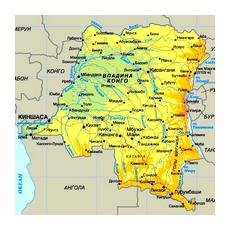 observing its inhabitants in their natural environment.
observing its inhabitants in their natural environment.
The number of citizens of the Democratic Republic of the Congo is growing rapidly as the birth rate is higher than the death rate. However, few people here live to old age (at least up to 60 years), and this is largely due to the difficult climate for life.
About a third of the population is urban, most often they prefer to go to Kinshasa. There are many nationalities in the country, each of which can speak their native language, but almost everyone understands French, which is a relic from the colonization period.
Although the country has rich deposits of minerals, the mining industry is not able to work on full force because of the crisis. Therefore, the economy is kept at the current level thanks to agriculture. The following crops are massively grown:
- cocoa;
- coffee;
- rubber;
- peanut;
- cotton;
- bananas.
These goods, as well as natural resources, are exported to different countries on all continents.


